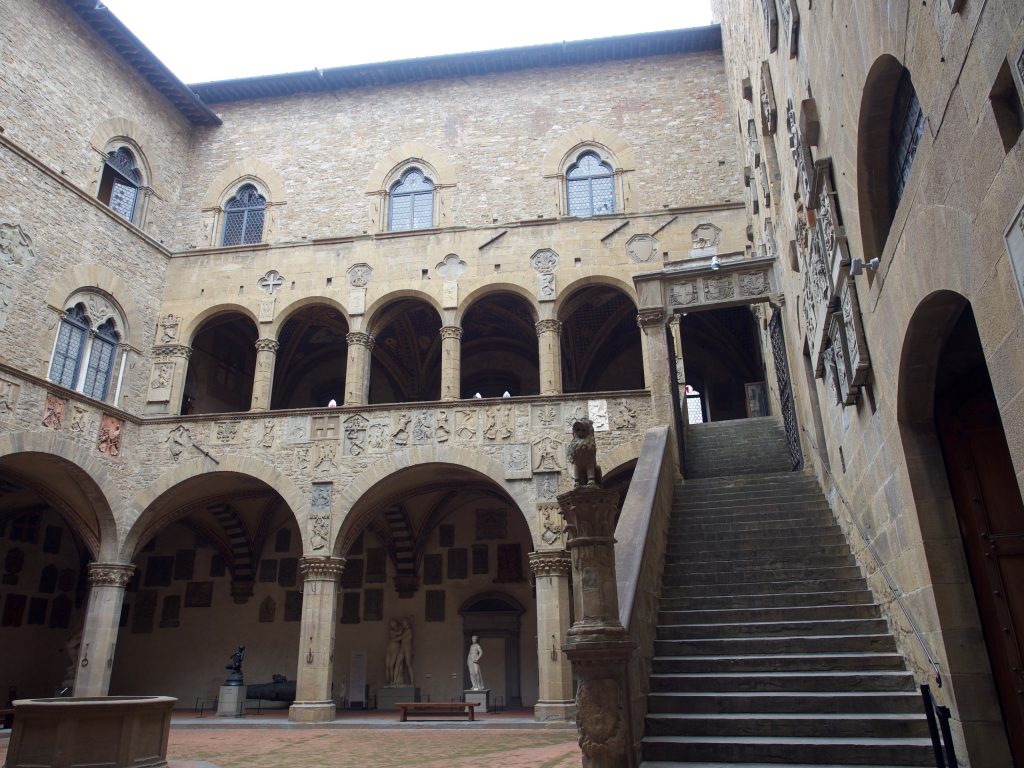
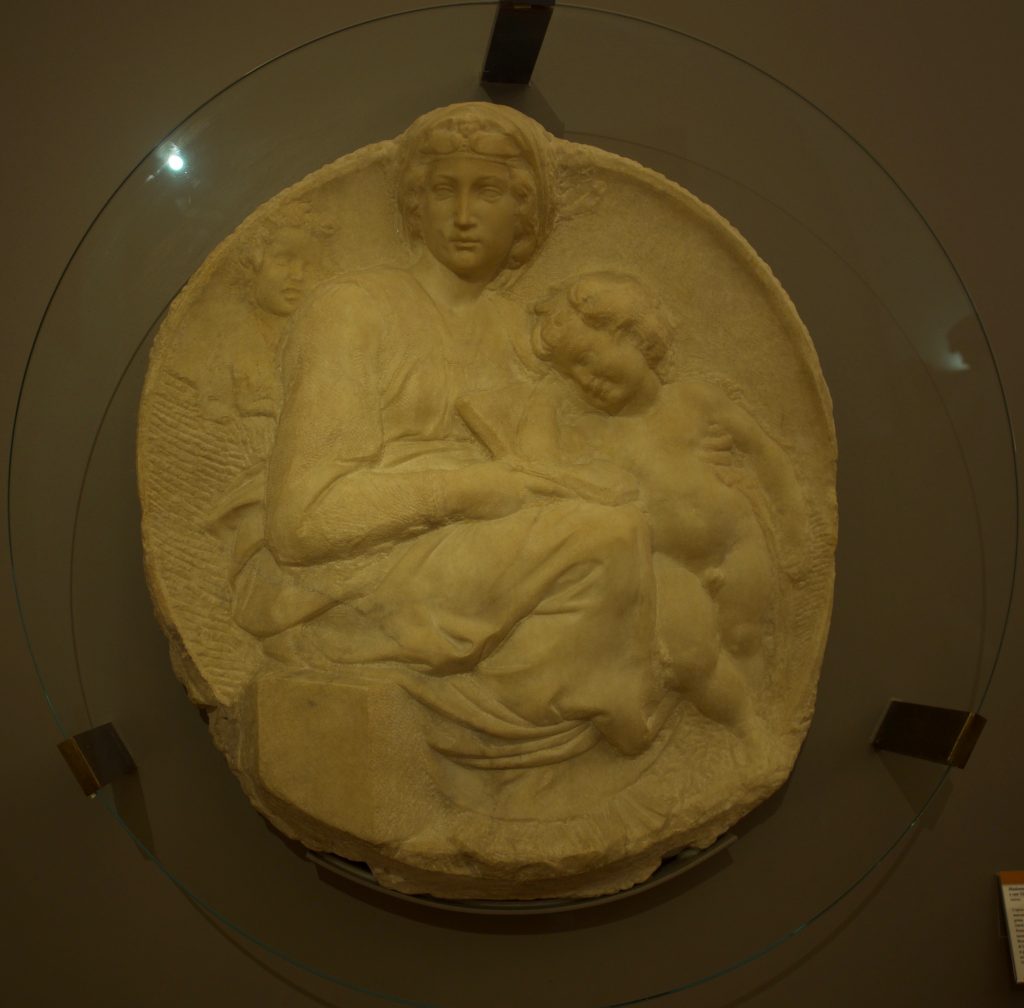
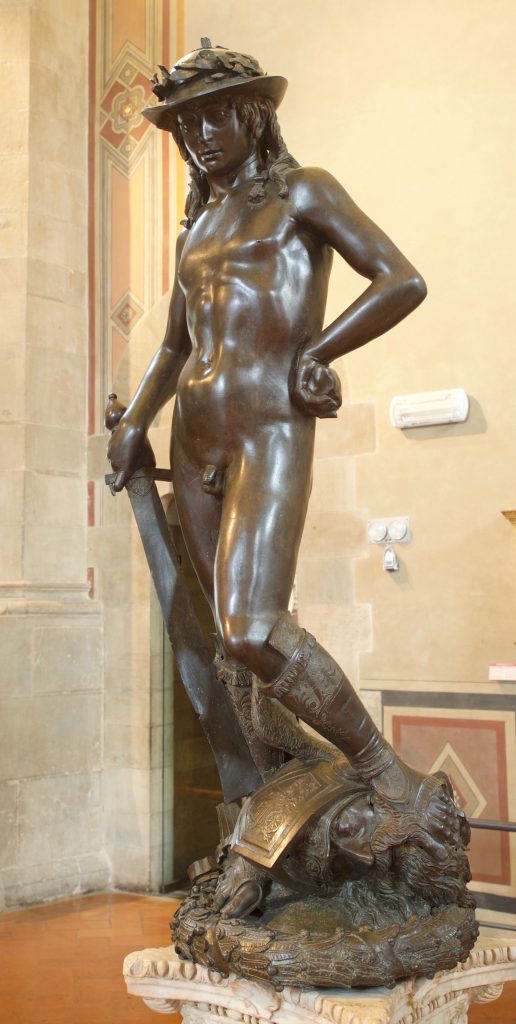
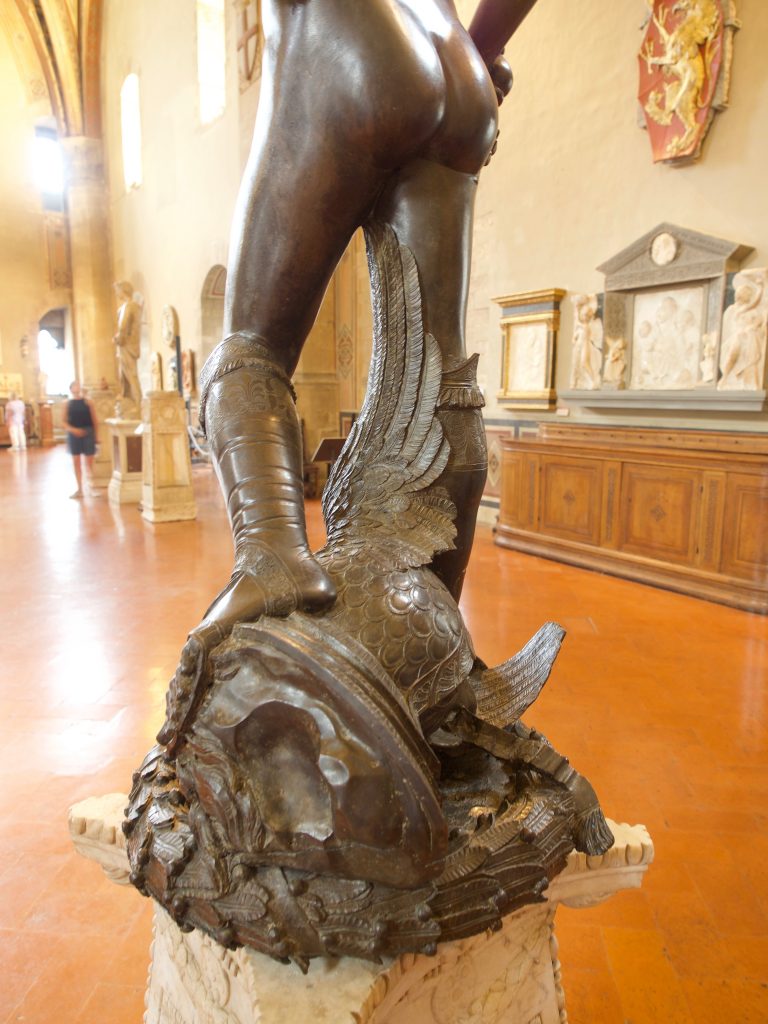
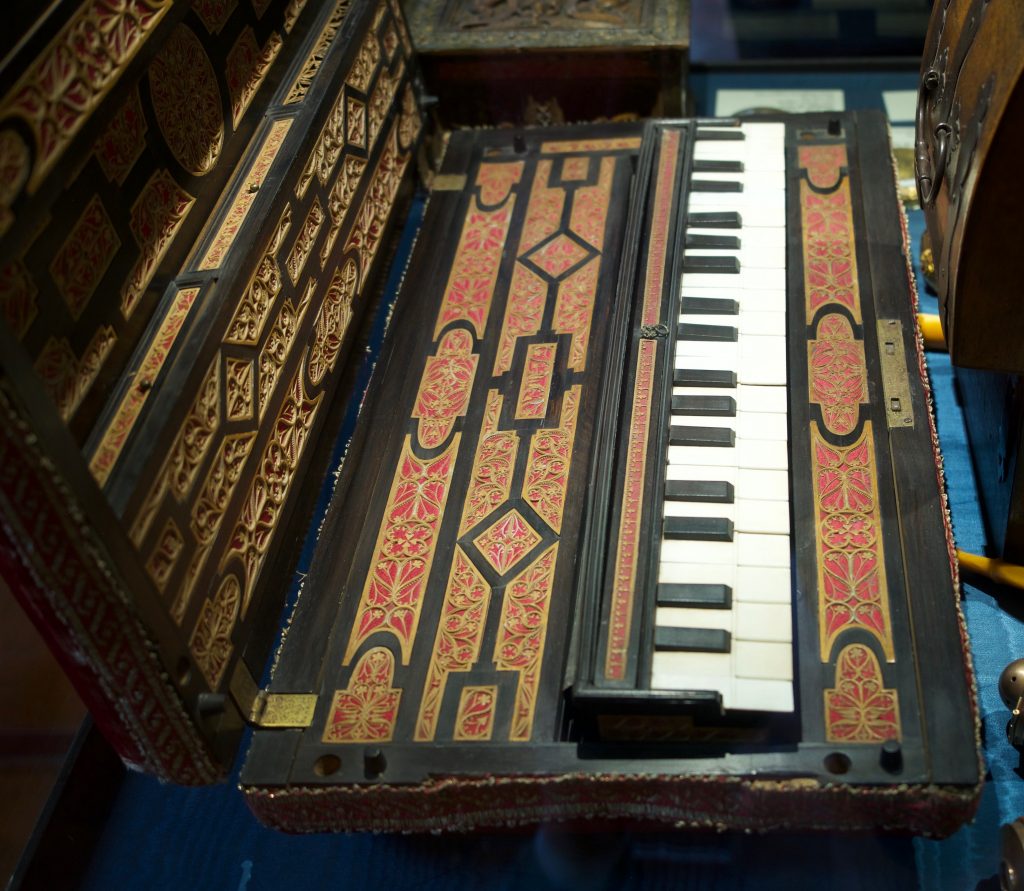
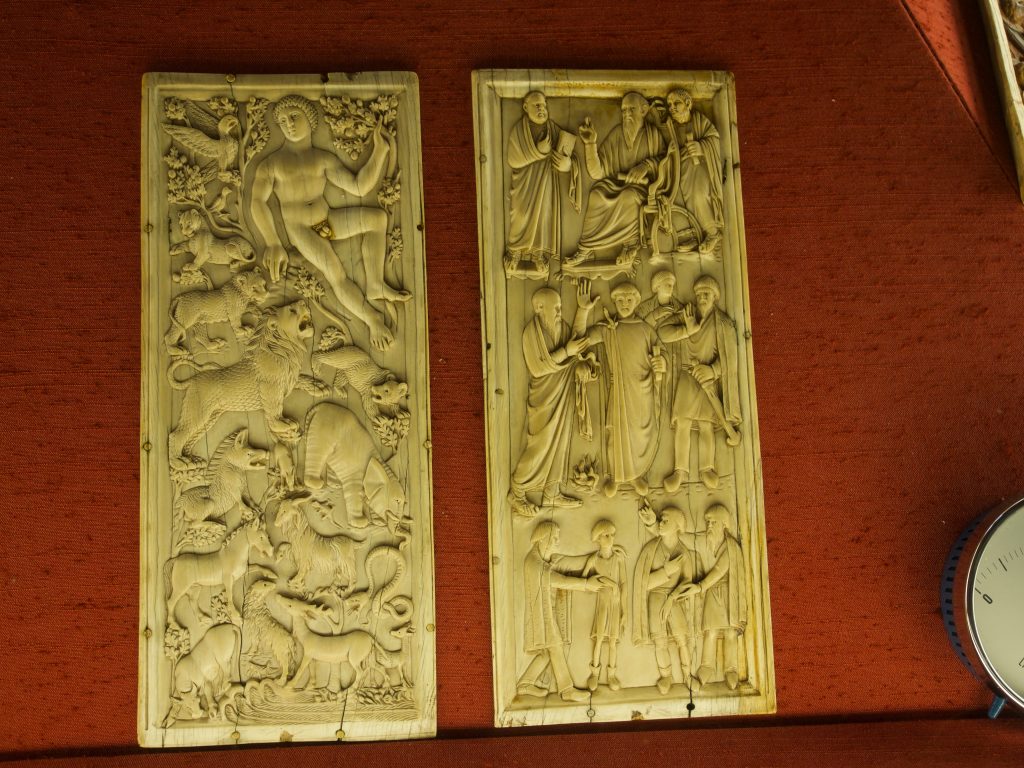
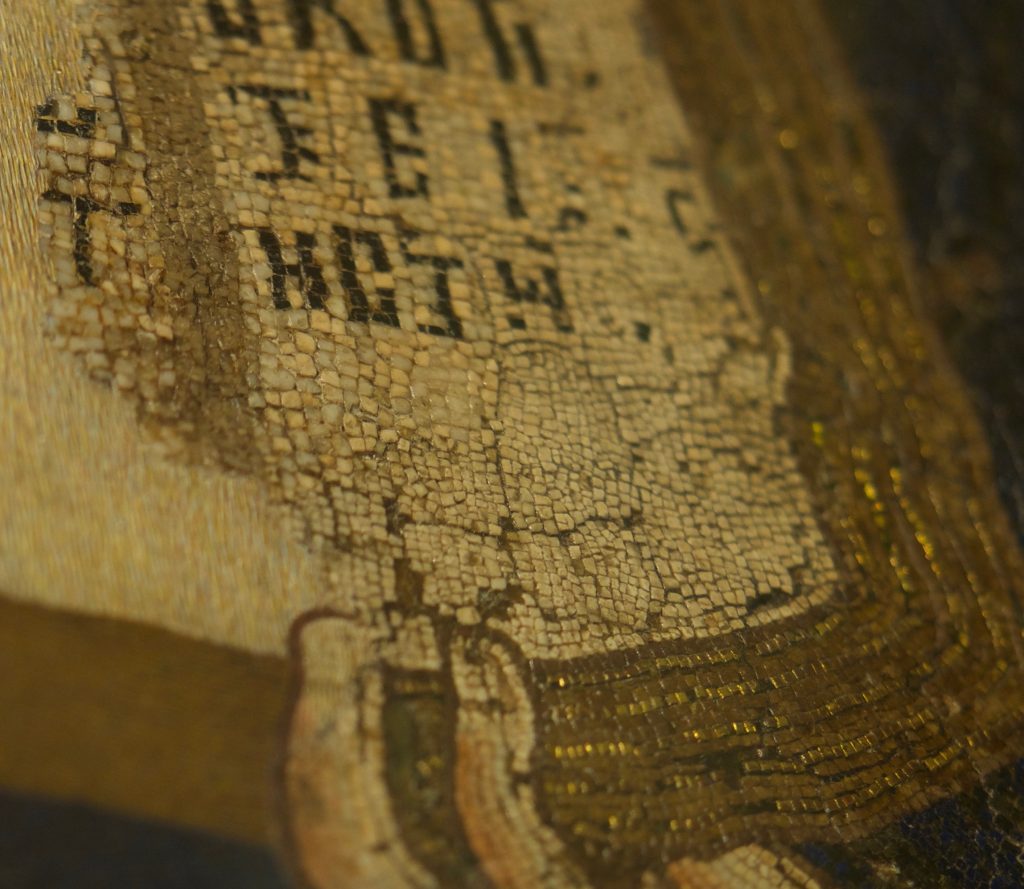
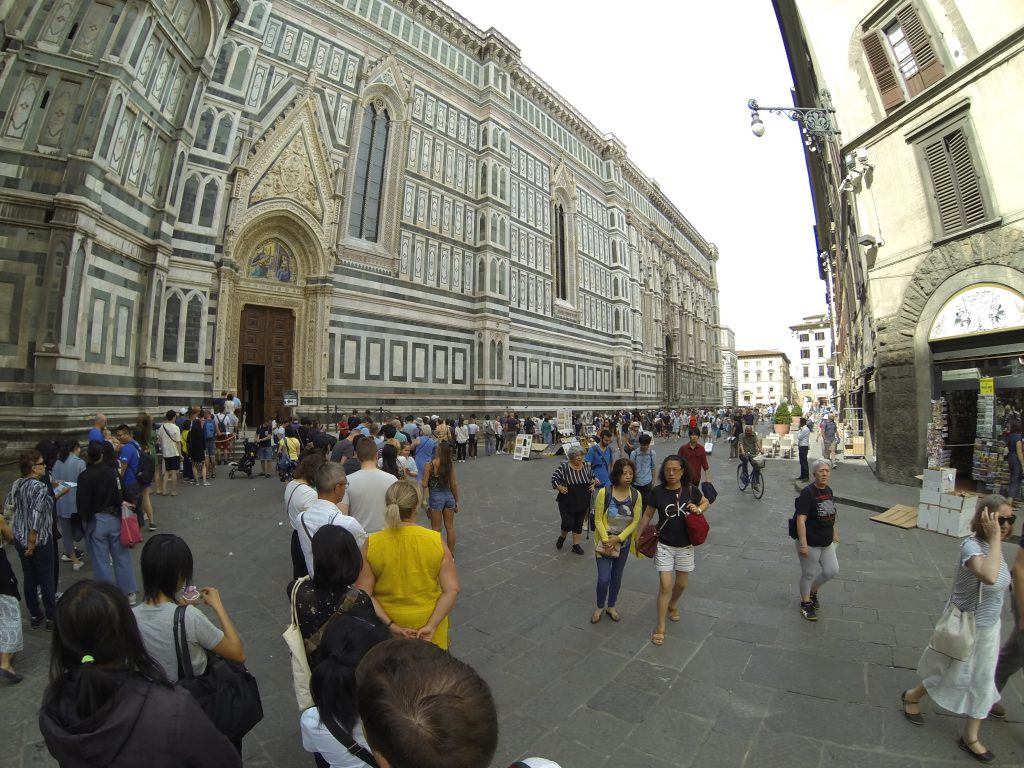
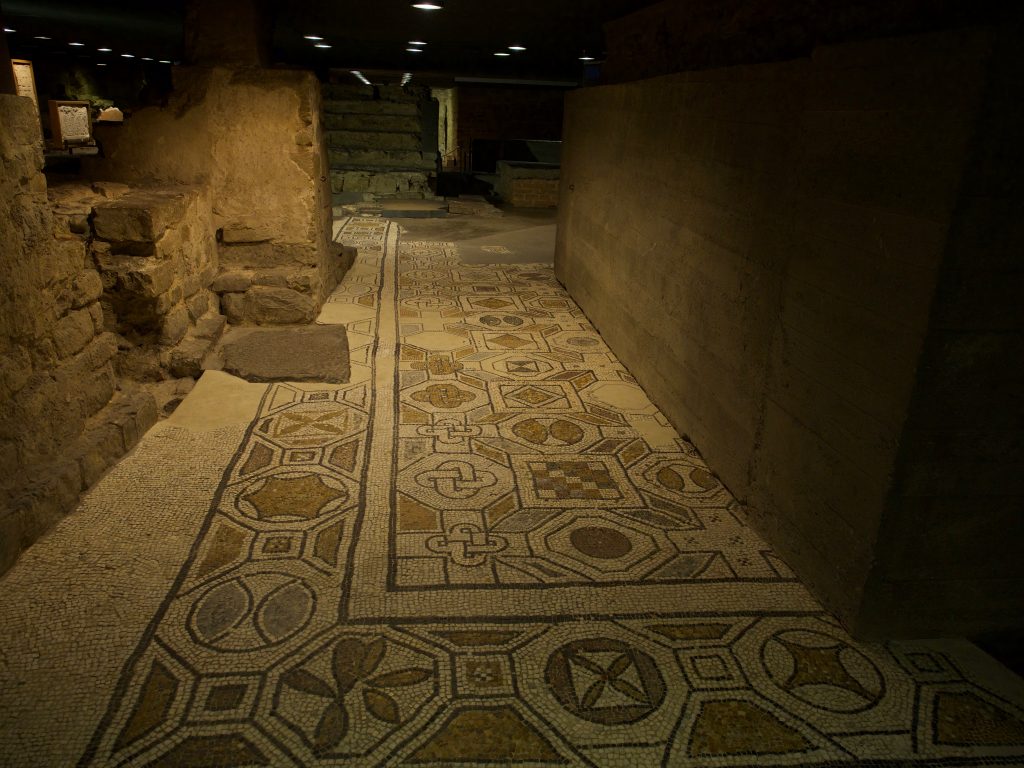
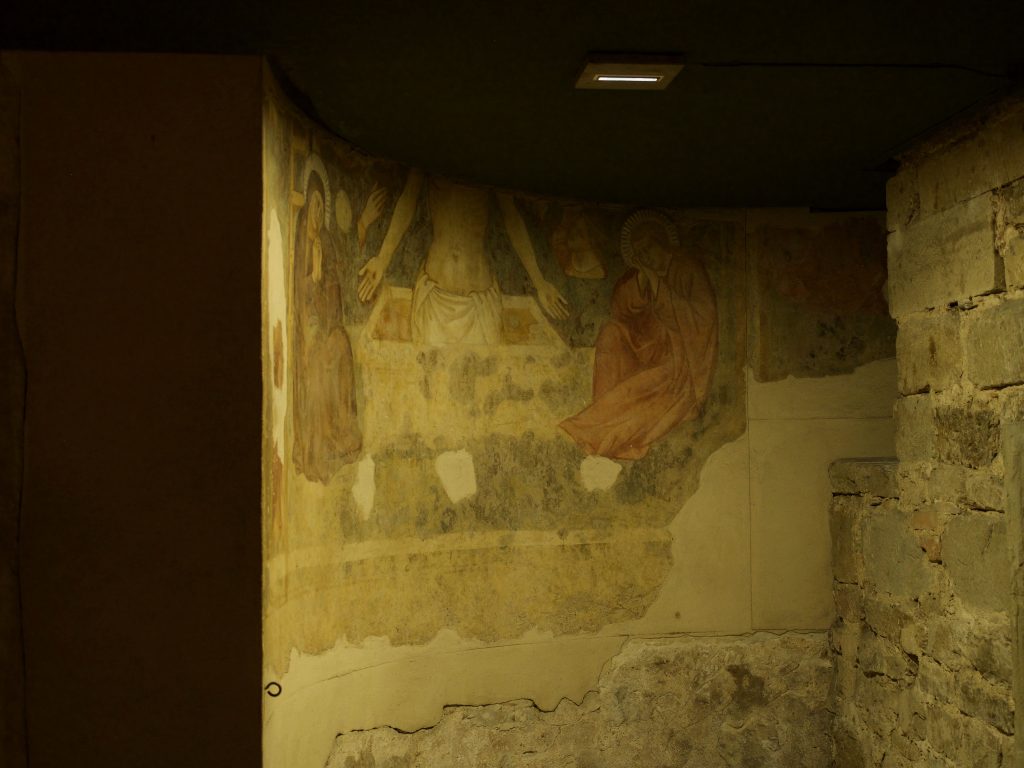
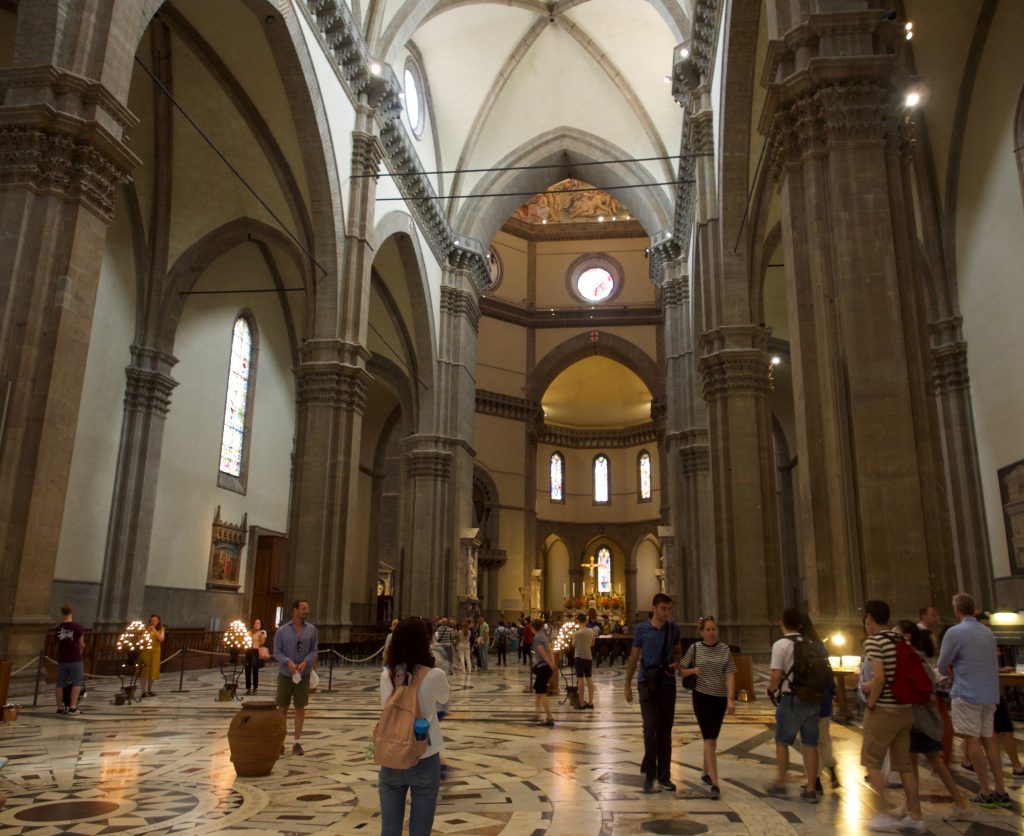
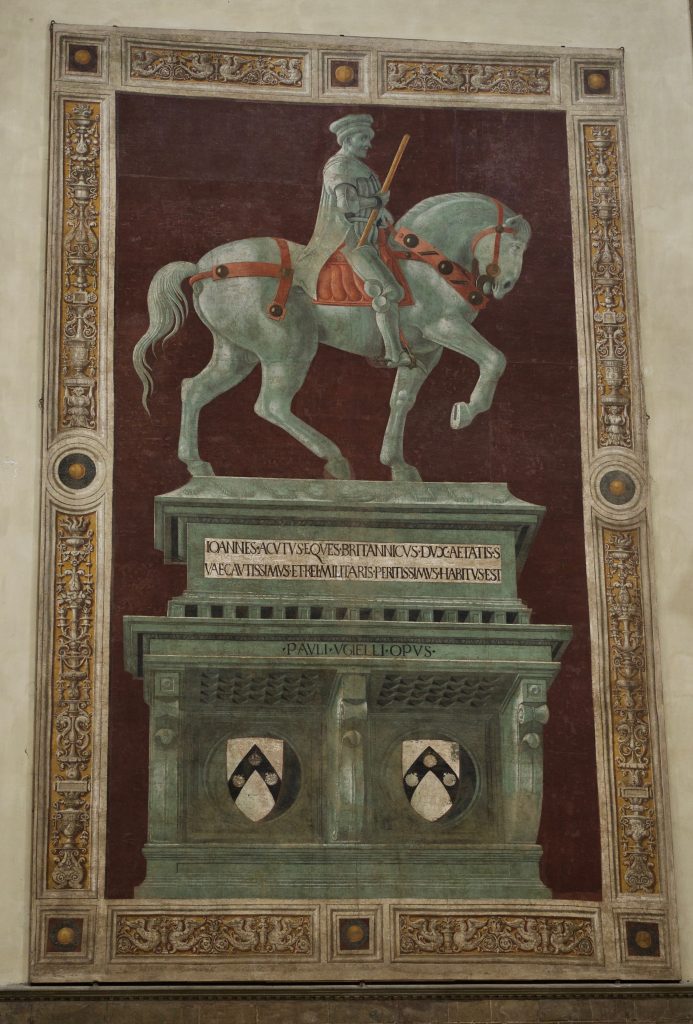
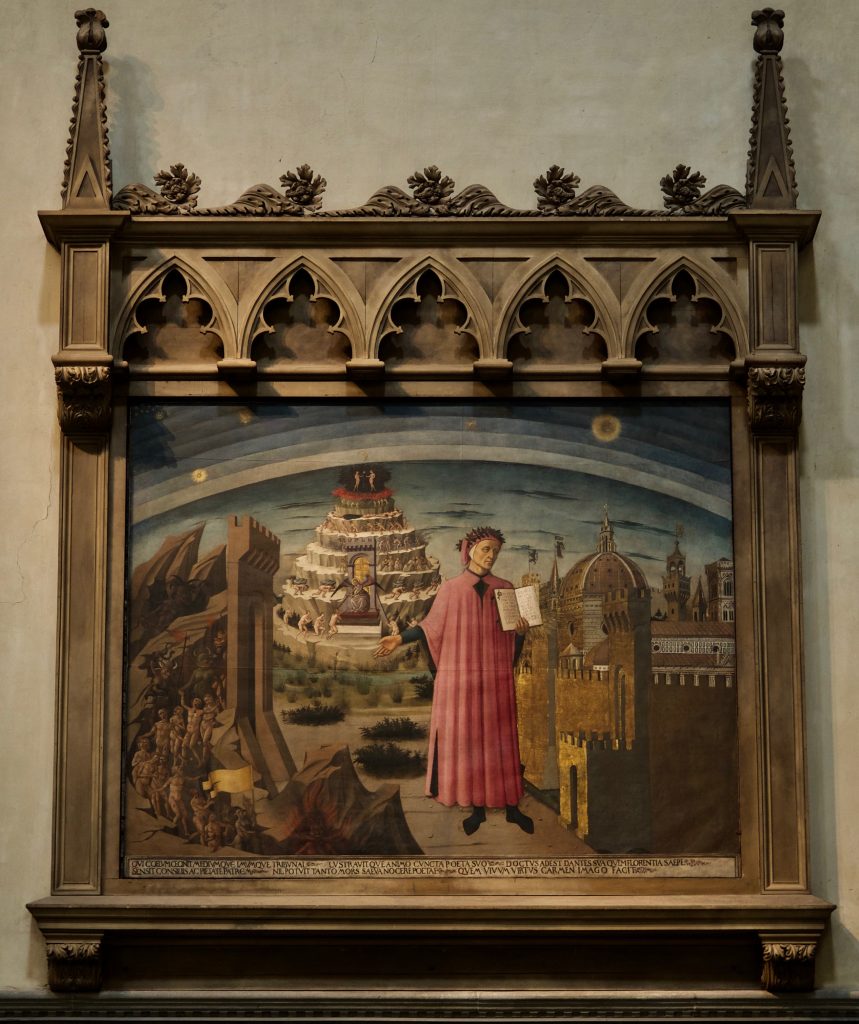
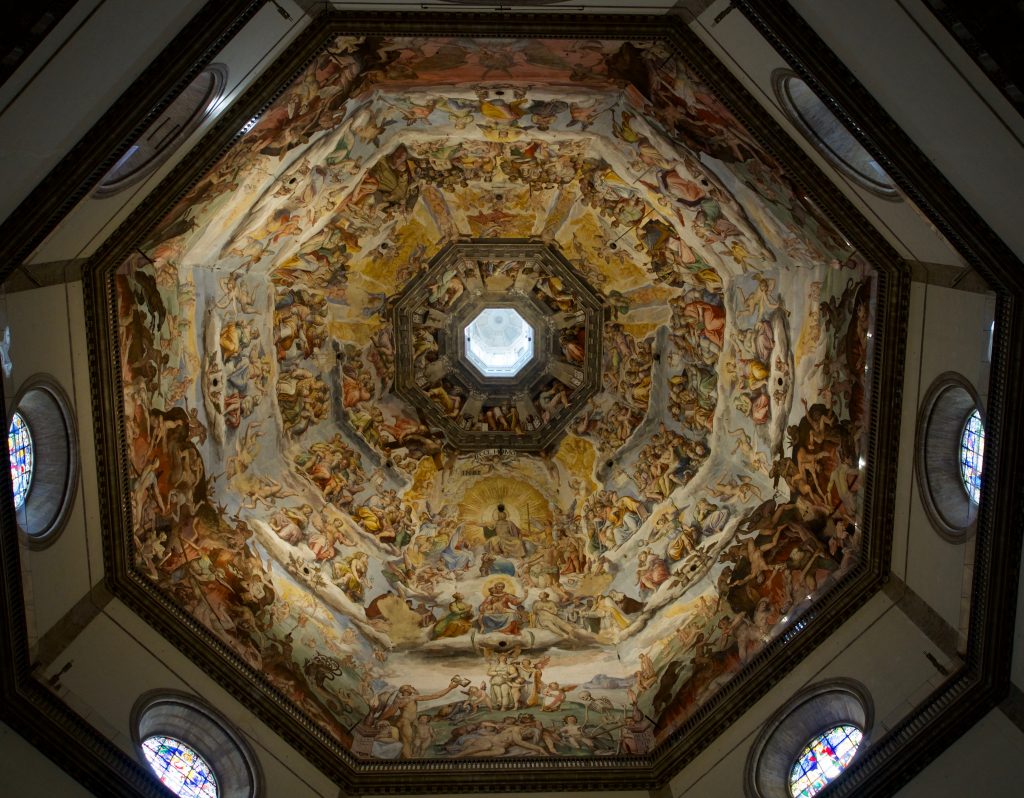
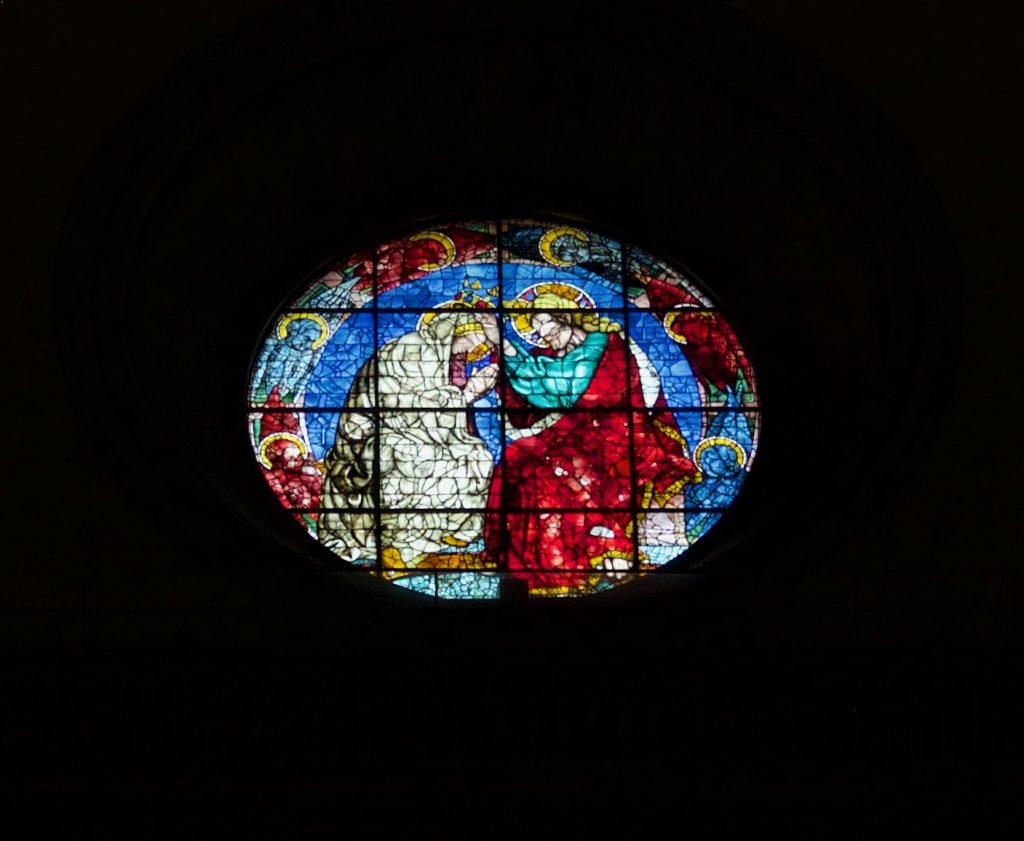
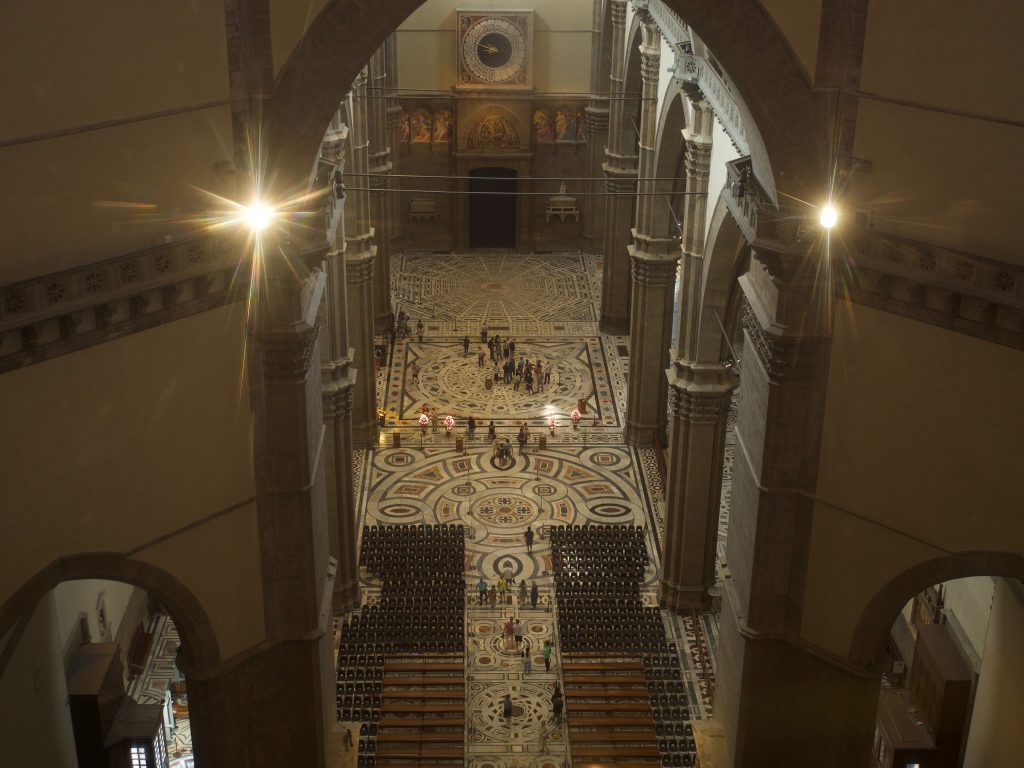
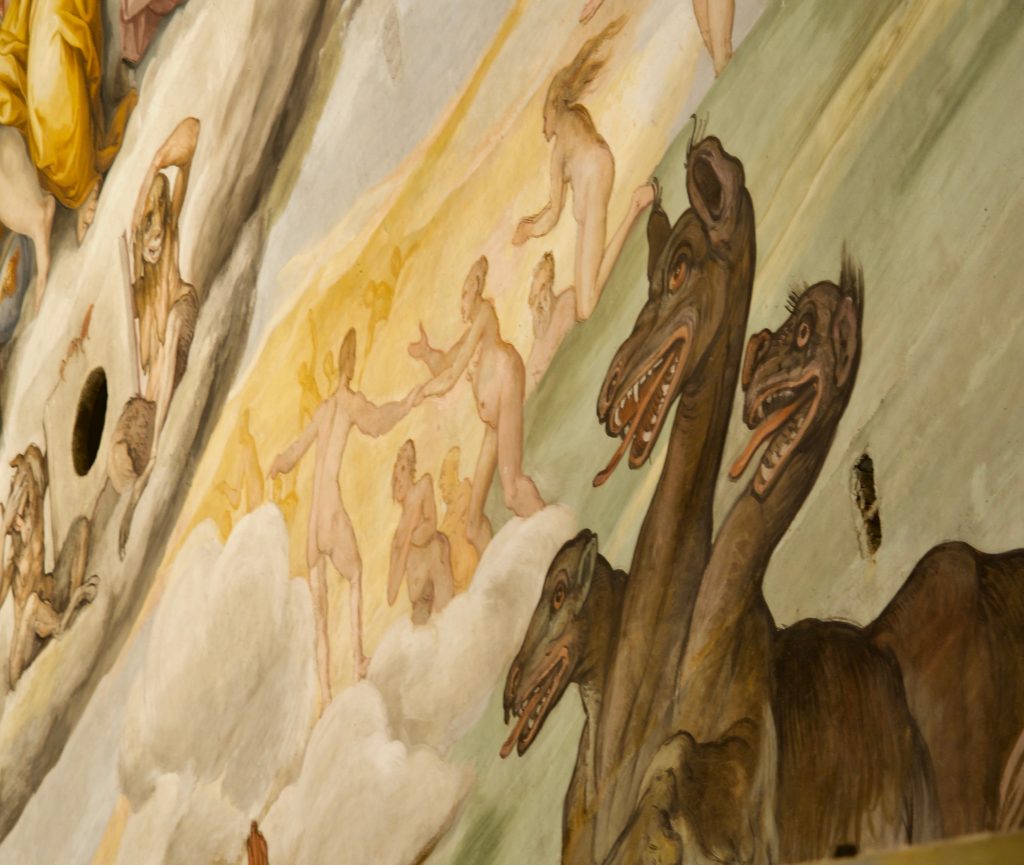
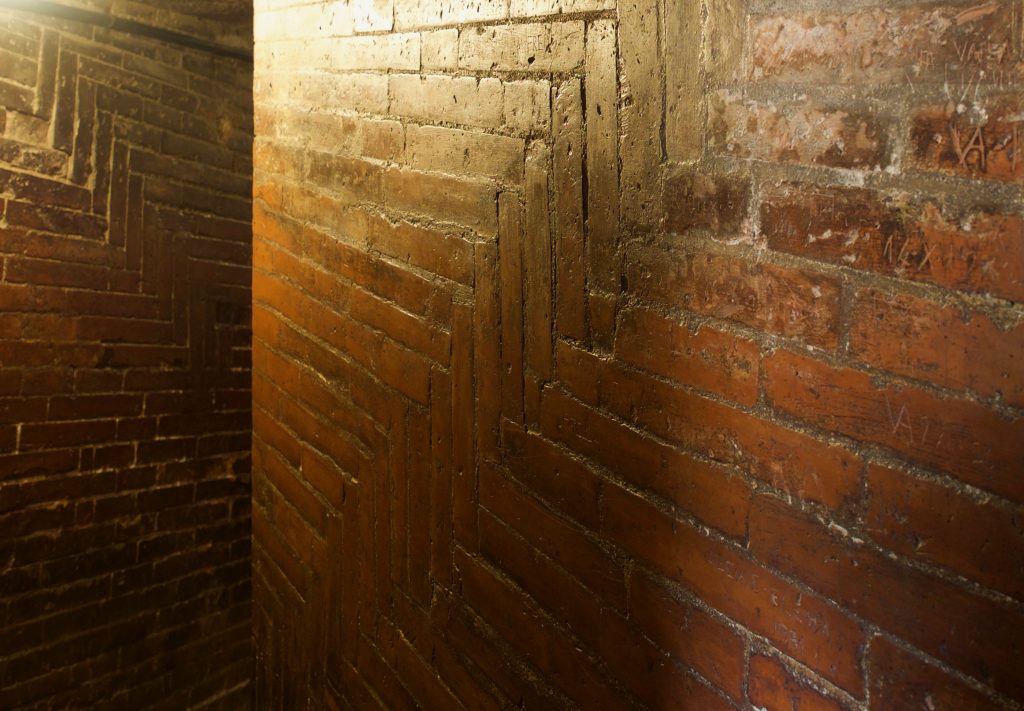
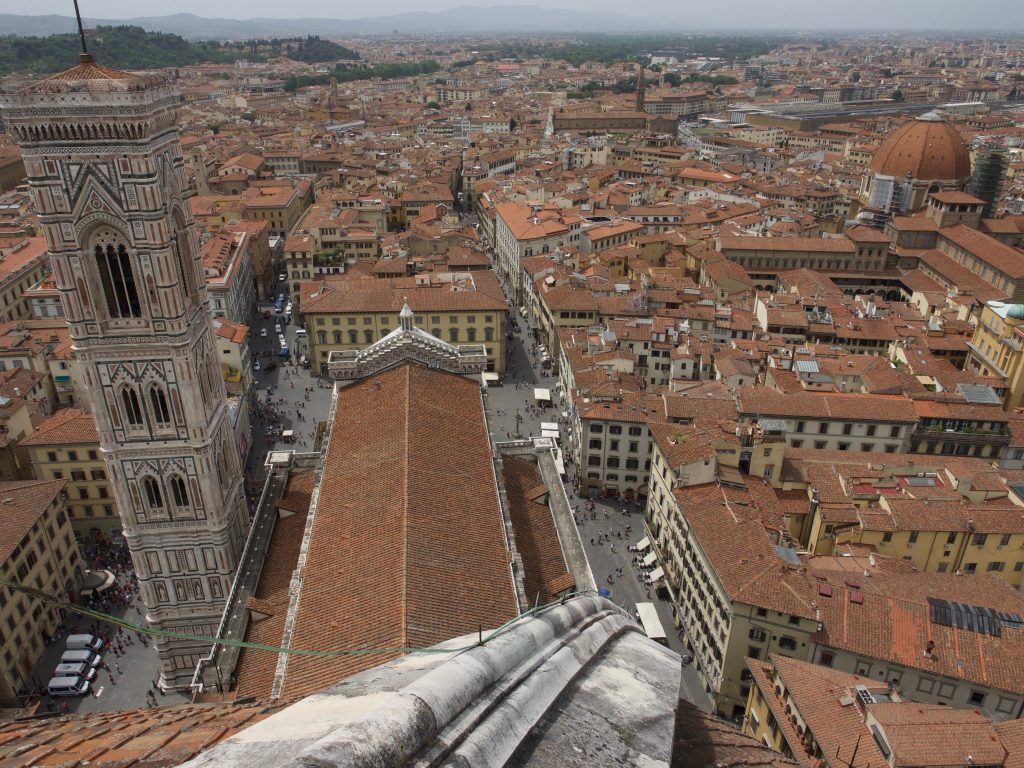
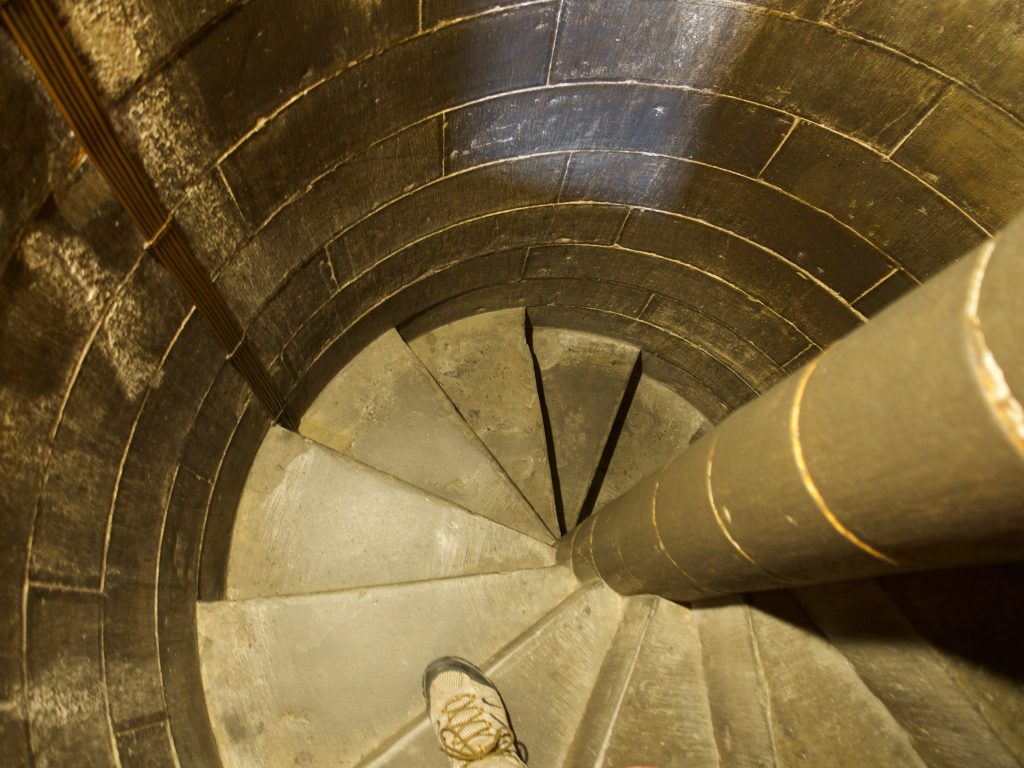
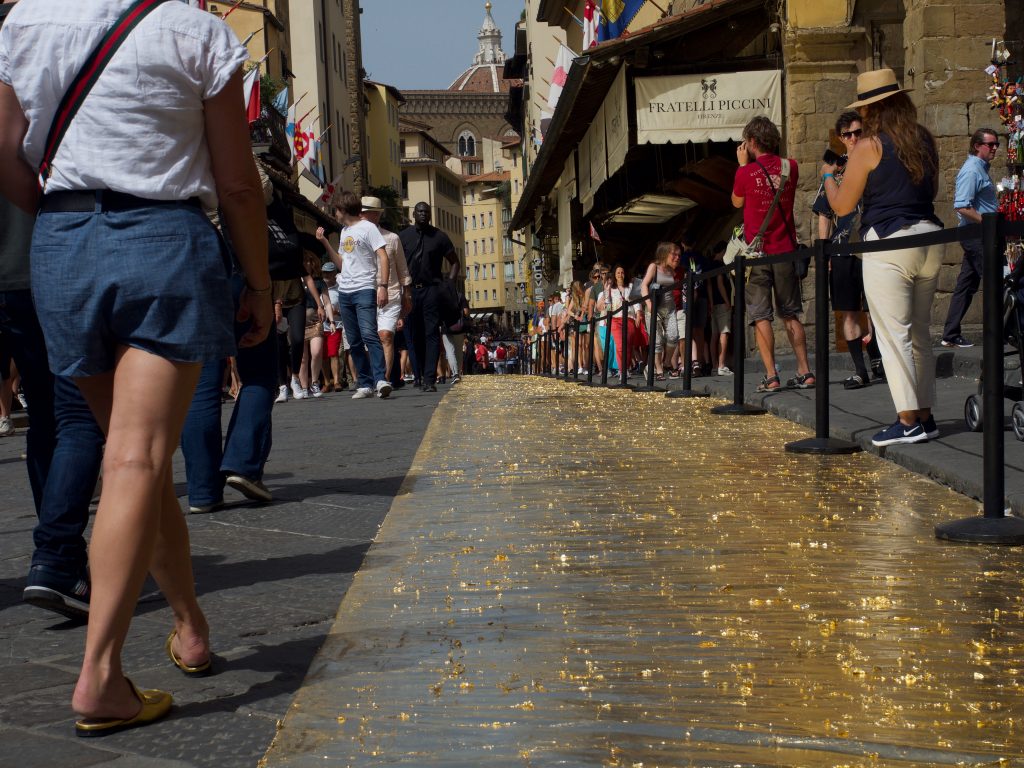
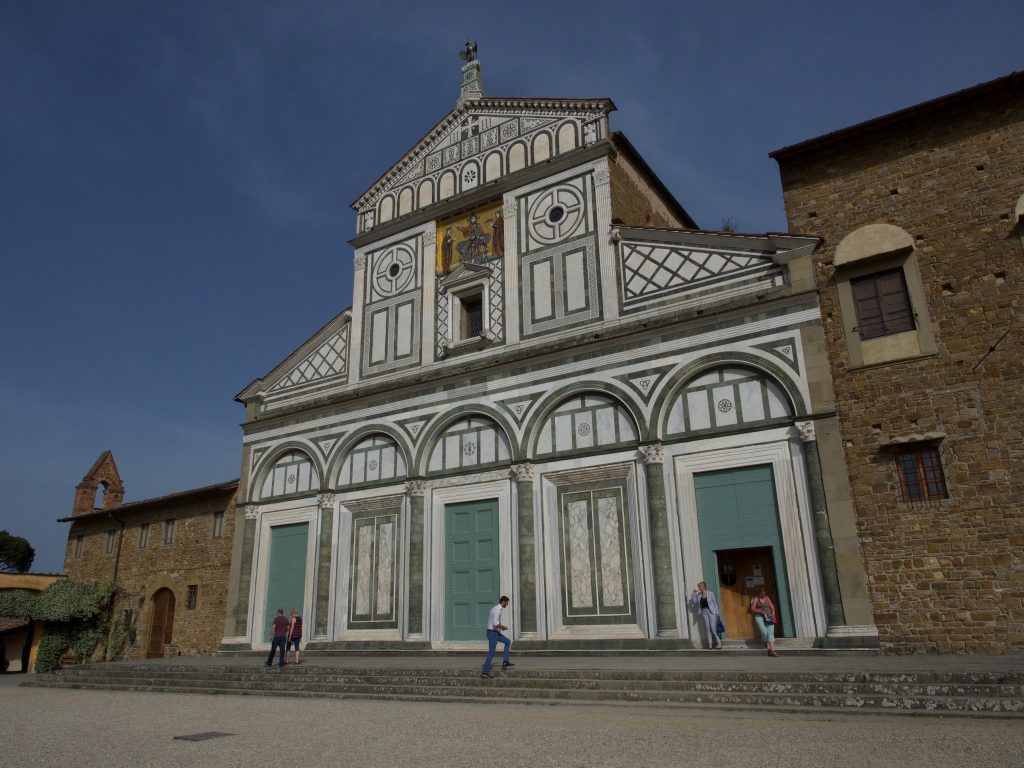
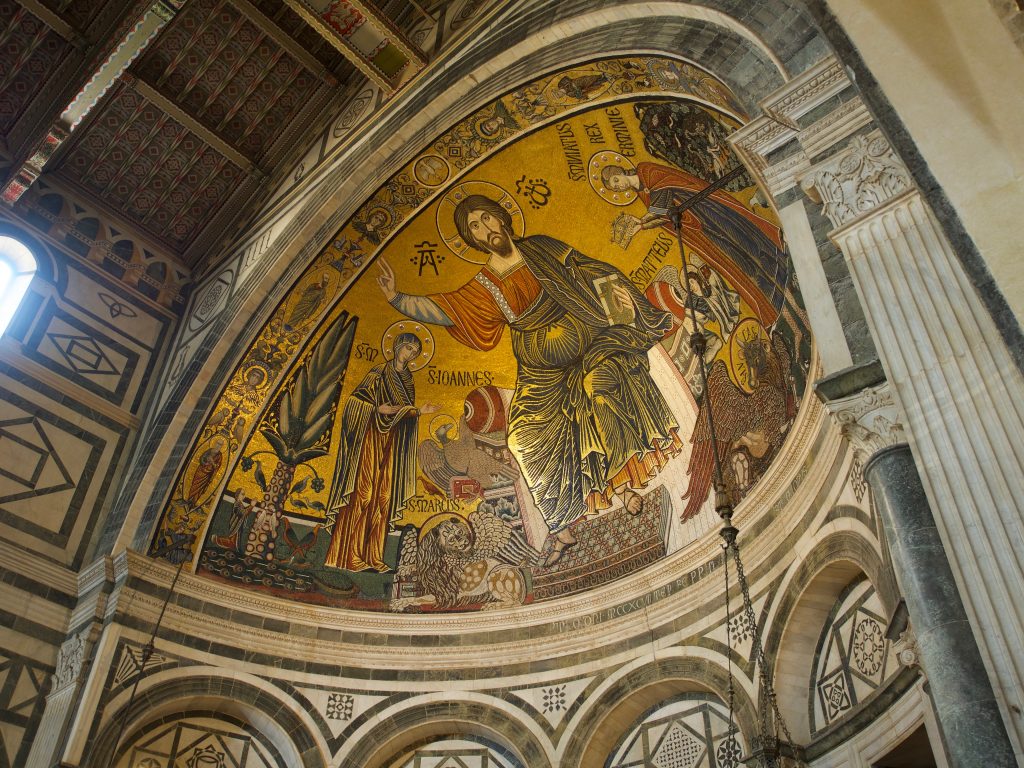
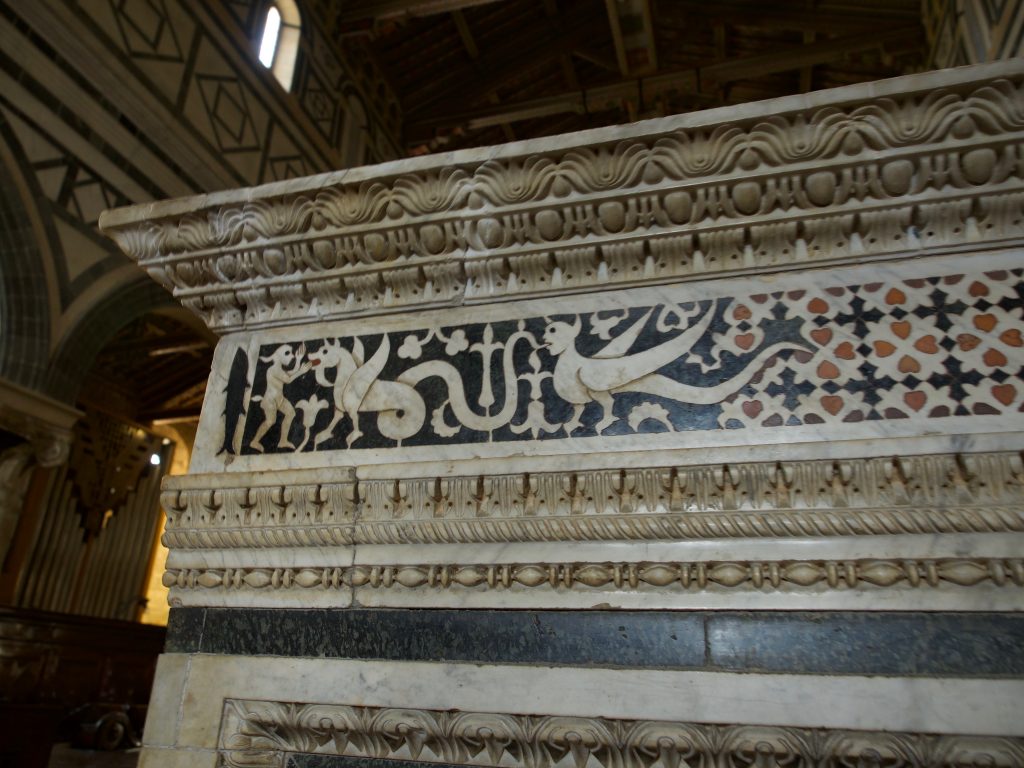
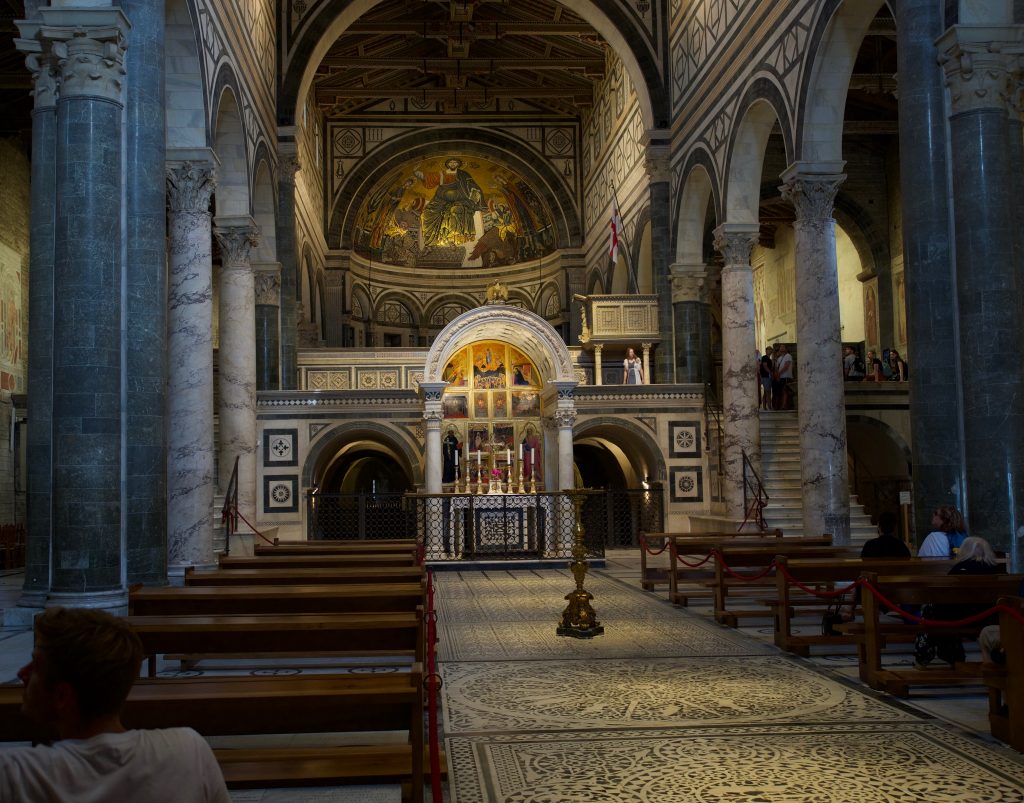
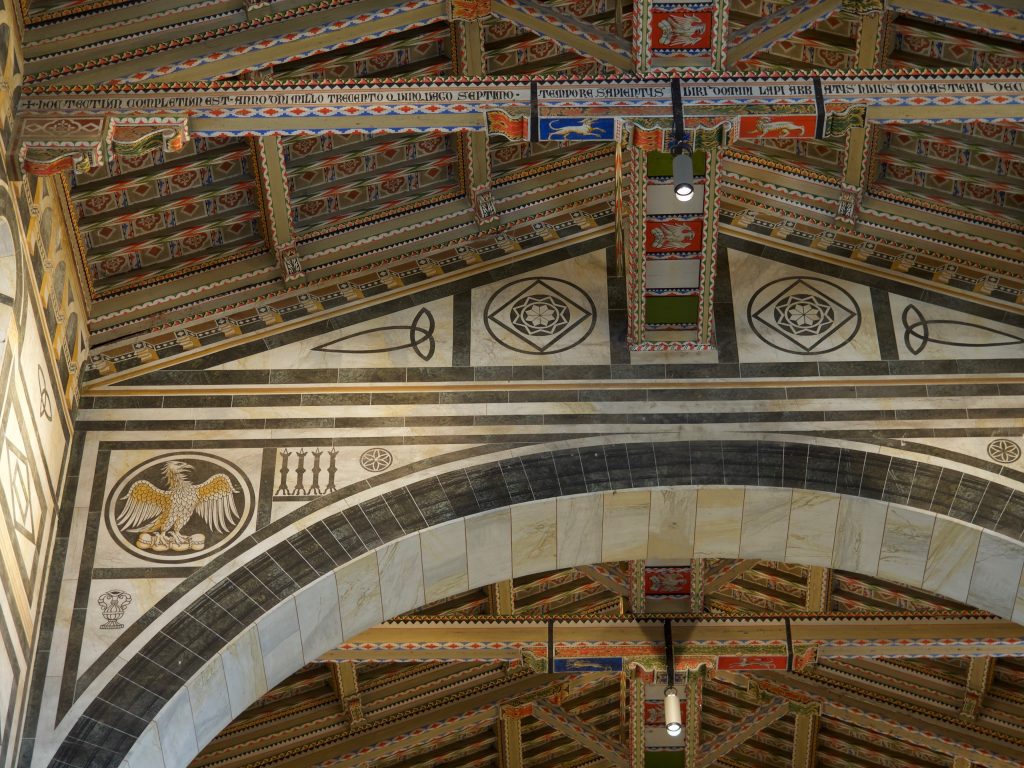
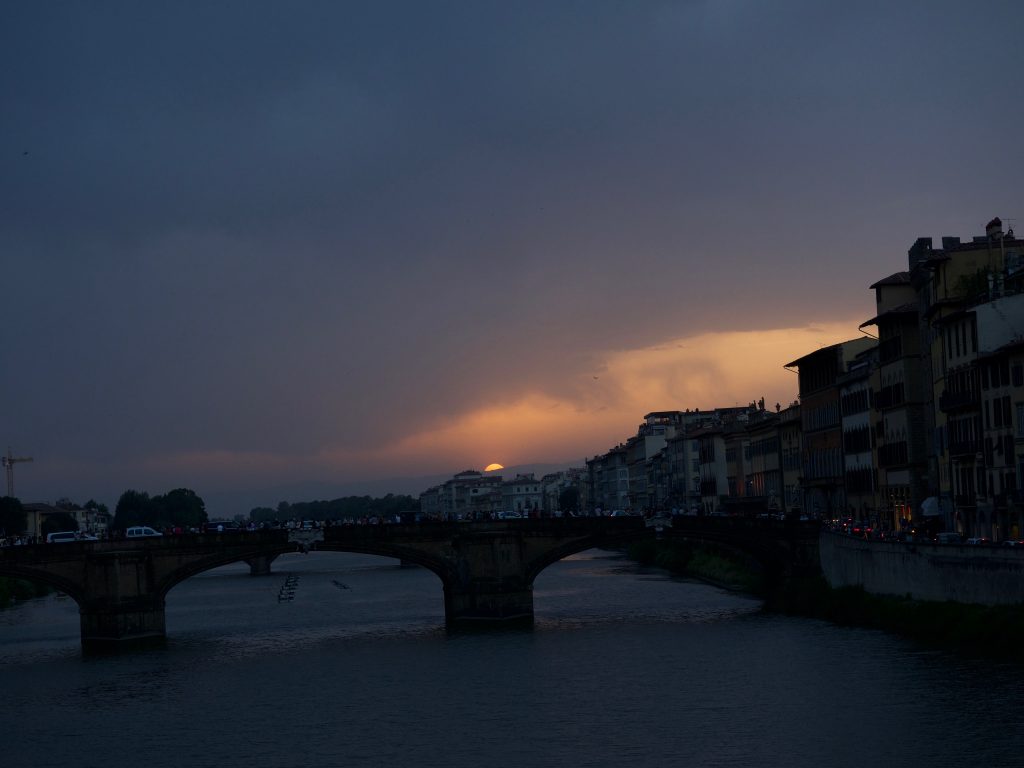
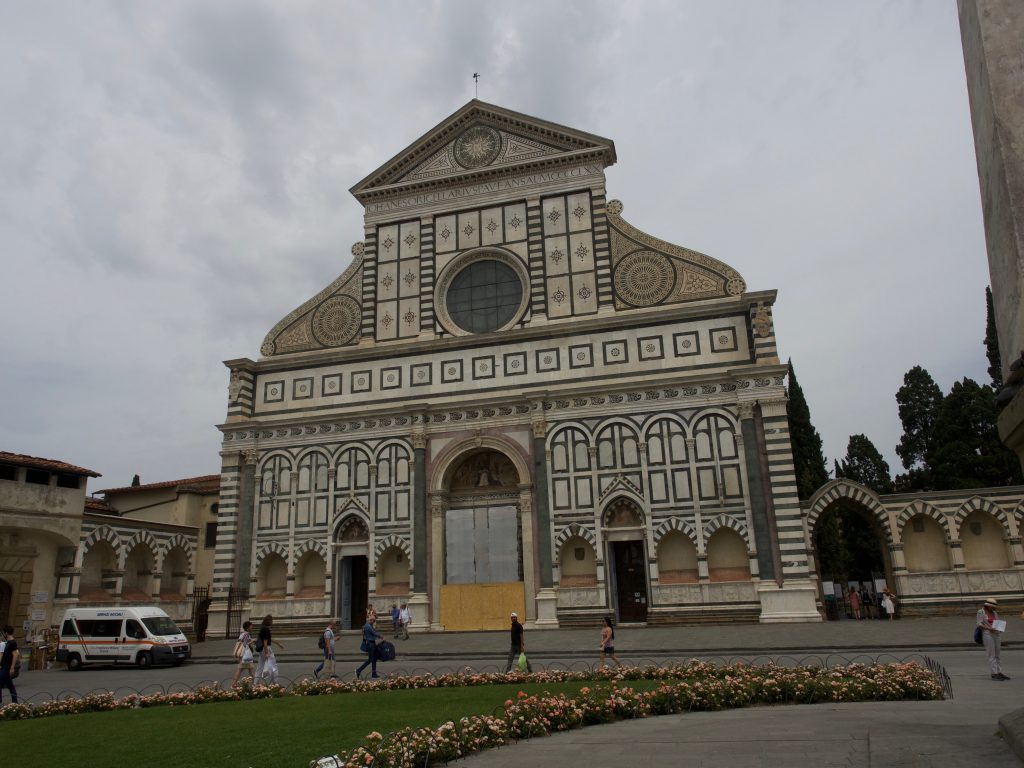
We got up bright and early to be at the Bargello right as it opened, at 8:15. By this time, our 72-hour clock had almost run out on the FirenzeCard, but we were hoping to just get in before it expired. That worked and I have to admit that the Bargello was more impressive than I thought, since there are many additional sculptures that were once outside or otherwise didn’t find any room in the big museums. As the “government building” in the early early 13th century, before the decision to build the Palazzo della Signoria (i.e. the Palazzo Vecchio, which wasn’t “vecchio” = “old” then) and then later the police headquarters of Florence, it looks a lot like a very imposing and strong castle and has always been a public building—now the receptacle of public things from all over Florence. I was most excited to find both of the Donatello Davids there, and really impressed by how close we could get to inspect the bronze David he made for the Medici courtyard, with the feathers from the helmet of Goliath that sensuously creep up David’s leg all the way to his crotch. But there were also two early Michelangelos, and the unfinished tondo relief of the Madonna and child was quite beautiful. I am really intrigued by the unfinished pieces and the way you can see all the different ways he carved the marble (not that everyone else isn’t! But they weren’t into showing workmanship in the Renaissance, so only his incredible fame even while alive made people preserve his half-fine work and his sketches.
But beyond the super famous things, there were so many more things to see, starting with the massive cube of the Bargello itself with its big square courtyard and the upstairs loggia, and the huge sculpture rooms. The collection of little things (watches, locks and keys, earthenware, jewelry, carved ivory…) intrigued Mark as well as me, but I was only truly awed at seeing some very early ivory tablets from the early Christian Era, especially at the detail and precision of the diptych of St. Paul, 5th century AD, with the two ivory panels together only about as large as the size of a regular-size sheet of paper. There was also a micro mosaic of Christ Pantokrator (from the 12th century) with tesserae only about a millimeter on each side. Not to mention the 17th-century Casio e-piano that Mark discovered. 🙂
We then did go for the tourist glutton-for-punishment thing and lined up for the Duomo, behind probably 500 other tourists. Since it is free, priority access doesn’t help at all, but we actually only had to wait in line for less than an hour, and chatted with an interesting (and obviously quite wealthy) young Australian couple with a very quiet 4-year-old. They were touring Italy for a month and then wrapping up with a Disney cruise that would take them to Barcelona. Wow. Actually, that conversation was probably more interesting than the interior of the Duomo itself, which is really just big and at the same time with little too see—a few select works (like the weird Dante portrait and the frescoes pretending to be equestrian statues that I had to learn about in Art History 102, one of them the British mercenary soldier Sir John Hawkwood, by Paolo Uccello) and a lot of roped–off space. The stained-glass windows were really too far off to be clearly visible except to Mark’s camera, and the Last Judgment in the cupola was really not that exciting from so far down below although Mark took an awesome shot of it looking straight up (more about the close-up views later). But luckily, they still let us into the crypt (although our tickets had technically still expired) and that was very cool! There were four different layers of excavation—one Roman, one early Christian, one Romanesque, and then the actual dome crypt from the 1300s. To see all those layers was really fascinating, especially the large swaths of early Christian mosaic floor, and the half-round of the apse of the Romanesque church, S. Reparata, that was torn down once the cathedral went up. There was even a bit of a fresco visible that was “refreshed” and stylistically updated really close to 1300, when the new cathedral was already going up around S. Reparata.
After we were done with our quick tour of the Dome and the Crypt, we found ourselves a little side street cafe where you could get tosta, which is basically a very dry and large panini, and we ate those on the street sitting on little stools in front of the shop, with hungry tourists eyeing our meal rather hungrily. We had just enough time to wander a bit East from the plaza by the dome, and check out a couple of sites from the outside that I wanted to at least see and decide on—the Palazzo Rucellai, which was built before the Palazzo Medici, and has the iconic Renaissance Florentine 3 tiers of huge sandstone blocks, and also Santa Maria Novella, another church with a beautiful Romanesque “zebra stripe façade,” which we’ll return to in a couple of days. Then it was time to line up again, but this time only for a short half hour, because we had reservations for the climb of the Cupola at a fixed time, 1:30 pm—they had to be made over 3 days in advance because there is such demand, but we had done that first thing we came to Florence. It took a bit until the young man who was checking people through the turnstile could get his boss to approve that we could go in, because of course our tickets had, again, technically expired, but in this case, that’s the norm.
We were both very excited about the cupola, because we had read part of Brunelleschi’s Dome, in addition to what I knew from my classes on the Renaissance. With a diameter 144 feet (44 meters) the dome of the cathedral was the largest to be constructed since the Pantheon in Roman times, and without knowledge of how to make Roman-style concrete. When Brunelleschi started it in 1401, no one had the faintest idea how to build a dome that big, and there was quite a bit of guesswork as well as engineering brilliance. When you walk up, you walk up between the inner and the outer shell of the cupola, and although you can’t see much of the engineering secrets, you CAN see the herringbones once you get into the dome. The stairs were fun and Escher-sequel, and then the view from the top. We also got to walk both the balconies inside the cupola, right underneath the fresco, and Mark got a great shot of Cerberus, and of course the view down was awesome, even with the plexiglas we had to peek through. But if I try to imagine what it would have been like to work up there as a bricklayer/mason, on a suspended platform, no scaffolding below, I‘d rather have a railing and plexiglas.
After our Duomo climb, we headed back toward the other side of the river, and weren‘t even quite done with the climbing. We went back to the river, across the Ponte Vecchio, which in honor of a fashion show that is starting here on June 11 had a huge roll of goldleaf-covered “runway” going across it, so that it was literally paved with gold (appropriate for the fashion show, the enormous tourist traffic, and the jewelry stores that famously line the bridge on both sides), and got a few supplies for a later dinner that we dropped off at home. And then we went back up the hill to San Miniato al Monte—really only 10 minutes away—we are so close this area it is almost ridiculous—but it is a climb.
If San Lorenzo was my favorite of the several Renaissance churches with the modular, geometric style and really simple lines of pietra serena (the less baroque overlay, the better), San Miniato is absolutely my favorite of the older, Romanesque churches. We had already admired its placement on the very top of the highest hill of the Oltrarno neighborhood south of the river and its black-and-white marble façade multiple times from near and far on our walks. But now we actually went in, and I was amazed at how gorgeous it was—it’s incredibly simple and just very serene—from the interior black and white and the gorgeous mosaic carpet (all from the 12th and 13th centuries) to the amazing color accents of the roof beams, from the little separate Renaissance altar (designed by Michelozzo) to the Italo-Byzantine Christ Pantokrator mosaic in the half-dome of the apse over a huge presbytery to the frescoes with their many Benedictine monks in white in the sacristy, beautifully restored, it is just amazing. But the biggest surprise came later, when I read up on an unresolved question in one of my guidebooks. Since this was really an early, pre-Renaissance church, I couldn’t figure out why it had these amazing columns supporting the apse that had classical columns complete with “leafy tops” (Corinthian capitals), because as much as I could tell that the altar was a Renaissance addition, it would simply not have been possible to “retrofit” those capitals on weight-bearing columns. Only the Blue Guide made me realize that this is because they were taken from Roman temples of the surrounding area (how they hauled them here, I have no idea). That was mind-boggling to me, especially given that it’s hard to see the faint Roman traces beneath Florence at all anywhere in the city.
After this amazing visit to San Miniato and the minor ‘next-door’ church that is also on the hill, we walked back down to our apartment, stopping at a beautiful little rose garden half-way down. Then I made salad and pasta with pesto for a delicious dinner (I have to say I am really proud of myself for making us these fabulous Italian dinners every night have full-time and overtime tourism, and I have now mastered the LaVazza at least for espresso, although it must be actually defective when it comes to steaming milk, which makes me sad. And then we went out right before 9 pm for one more (marginal) sunset from the Ponte Vecchio and another gelato. We’ve been having gelato twice a day, which is a lot, but we always get the smallest portion (which in a good gelato shop gets us two flavors), and we have been walking an average of 10 miles a day, so I think it’s justifiable.